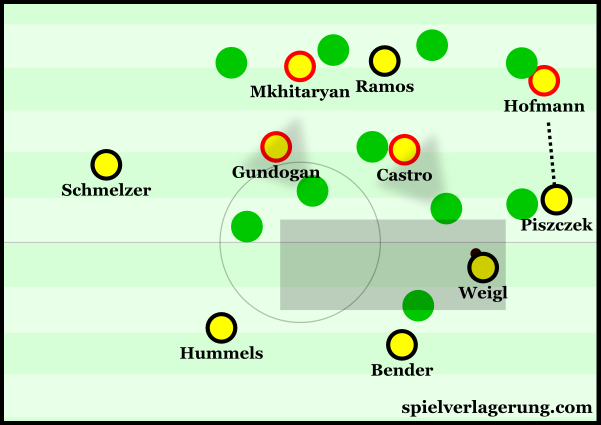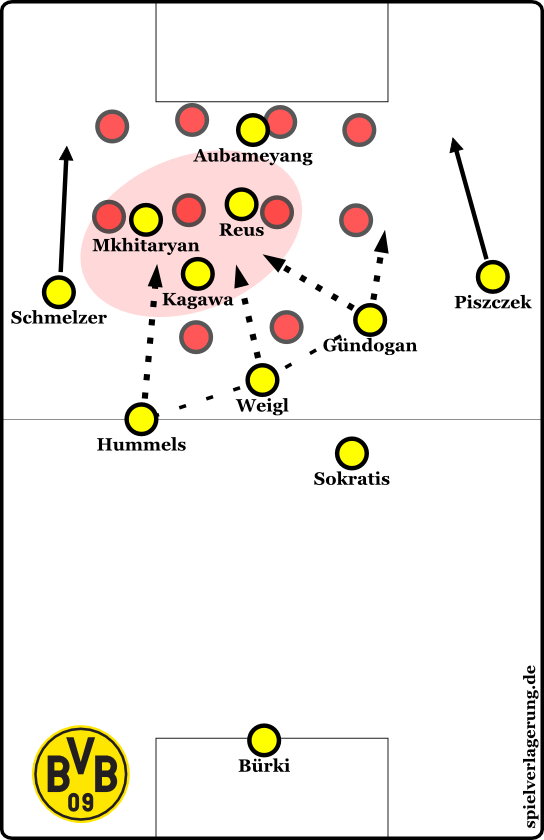FK Krasnodar – Borussia Dortmund 1:0
After a recent loss to Hamburg, Tuchel’s Borussia Dortmund again fell short this time in a Europa League clash away in Russia to Krasnodar. Despite having multiple chances and hitting the woodwork on three occasions, the German side ultimately couldn’t reply to their opposition’s early goal which came from a penalty in the first minute.
As is common with their European matches this year, the new manager fielded a rotated eleven and gave much-needed rests to key players such as Aubameyang and Kagawa. As a result, the system was altered and we saw more of a 4-1-4-1 shape take place with Julian Weigl the lone pivot as opposed to their usual shape which appears closer to a 4-2-3-1.
Roman Weidenfeller was chosen as goalkeeper, as has happened in all matches in Europe so far, behind a defensive line of Schmelzer, Hummels, Bender and Piszczek. After their loss in Hamburg, Sokratis was dropped to the bench in favour of midfielder Sven Bender.
Immediately ahead of the back four was Julian Weigl who looked to support a pairing of Ilkay Gundogan and Gonzalo Castro higher up, with the former situated on the left side of the triangle in contrast to his usual right-sided role.
On the left side of the attack was Henrikh Mkhitaryan whilst opposite the Armenian was the less-effective Jonas Hofmann in a more linear role. This created some asymmetry across the attack but was a change from the usual orientation of the wide men. Hofmann was much less ball-oriented in his positioning, and often would stay towards the right when the ball was on the left unlike Marco Reus does.
Together though they attacked behind Adrian Ramos who was the lone striker to ultimately create somewhat of a 4-3-3 shape. Without an attacking midfielder directly behind him, the Colombian dropped deep perhaps more than usual, whilst was unlucky in a few chances in front of goal.
Loss of the Playmaking Triple-Chain and Worse Diagonal Access
With Gundogan now in a left central-midfield position instead of his usual spot to the right of Weigl, Dortmund lost the playmaking chain which has served them so well in their standard system. Across the 3 of Hummels, Weigl and Gundogan BVB possess very strong playmaking abilities to open up the spaces ahead and break the lines of pressure – particularly around the left half-space.
However now in a more advanced position, Gundogan was taken out of this equation and thus couldn’t influence the build-up to as an extent. Instead, he was often more used once the line of midfield pressure had been broken yet, because of his absence in a deeper role, Dortmund struggled on this area of their game. With the midfielder in a higher position which his teammates are having difficulty to find, BVB’s integration of the world-class playmaker was lacking.
Gundogan was still effective once the ball did reach him behind the midfield lines and he created some good moments when combining forward with Mkhitaryan yet the trade-off probably weakened the team. One could consider it a situation difficult to avoid also, as Shinji Kagawa was in desperate need of a rest following a heavier schedule and these Europa League fixtures provide an opportunity to do exactly that.
The issues in their building-game were further emphasised by the weak spacing of the back 3 whilst the ball was in the first line. The distances between Hummels, Weigl and Bender were quite commonly too short which hindered the build-up play significantly. Probably most importantly, they didn’t manage to open the passing lanes to as great effect because the line was too narrow, meaning that they couldn’t stretch the opposition lines.
This was more-so an issue within the half-spaces which are usually opened up effectively though without the diagonal axis of Hummels and Gundogan particularly, they struggled in this match.
Perhaps in combat of this disadvantage, Hummels moved high in the later stages of possession to attempt to force an overload through the left half-space. It was generally done to variable success and he created a couple of decent chances particularly in the first half.
As I touched on above, the restructuring of the midfield specifically had an impact on the diagonal access during the build-up.
When bringing the ball out from the back, a lot of the passes were vertical from a central position and thus they couldn’t establish stable possession in the midfield through this. As explained in my analysis of Tuchel’s start in Dortmund, their build-up game is oriented around diagonal passing into the midfield. This can be used to break the lines of opposition pressure and open up the spaces in midfield better than through vertical passing.
Yet with both Gundogan and Castro taking high positions, Dortmund weren’t able to enjoy a strong access into the centre through a diagonal axis in the first phase of possession. With somewhat of a disconnection between them and the young pivot, Krasnodar were able to block the passing lanes in most situations.

Generally weak spacing from BVB meant that they couldn’t build diagonally from the back as successfully.
Left Half-Space Provides less Penetration
With Gundogan and Mkhitaryan both around this area, Dortmund still maintained their focus on the left half-space but struggled to create as much in doing so.
Down the touchline, Schmelzer was making many runs behind the defensive line in search of balls over the top. This was quite different from his usual role which, albeit still direct, was not as fixated as he was against Krasnodar. Through making such movements, he often disconnected himself from the attack and a potential passing option was lost whilst his capacity to stretch the defense was also reduced.
With Hofmann in for Reus, a big difference was the action of the right winger whilst ball possession was around the left half-space. The young German rarely came inside towards the centre of the pitch which is a common action for Reus as it allows the team to overload the centre and break through there, whilst leaving Ginter as a possibility for a switch. However without that extra man coming across, Dortmund’s overloads were less effective and breaking through the left half-space was more difficult because of that.
Gundogan’s presence in his new position showed potential, as he did threaten after receiving the ball behind the defensive line but the overall force of the attacks was not to the same degree as with Kagawa in a similar position.
Aside from this there were also some rhythmical issues in their movements forward across the attack. The synergy was quite commonly lacking (particularly after the break) and a number of attacks broke down because of that. Whether it be through a player unnecessarily making a run behind the Krasnodar line or the movements towards the half-space not timed correctly, it made combinations quite difficult especially when you factor in Hofmann’s lack of involvement.
Conclusion
For not the first time in the Europa League, Tuchel rotated his side which weakened performance without star players such as Kagawa or Aubameyang. The likes were in dire need of a rest however and it therefore could be considered unavoidable for the manager and his staff. After two consecutive losses it is now key that Dortmund come back at home to Stuttgart and with some of their best players now rested they’re in good position to do so.




Keine Kommentare vorhanden Alle anzeigen